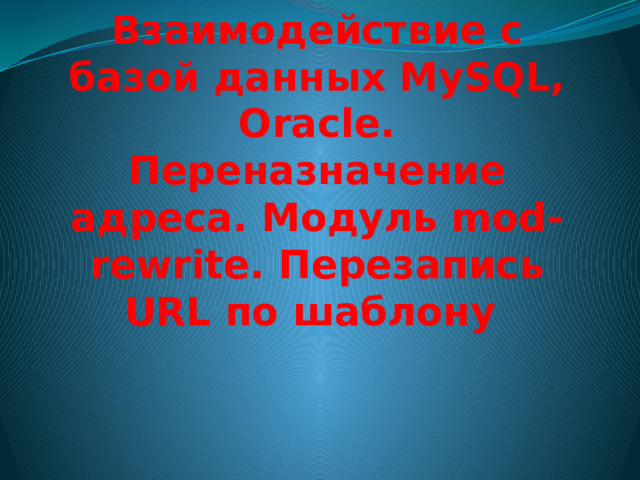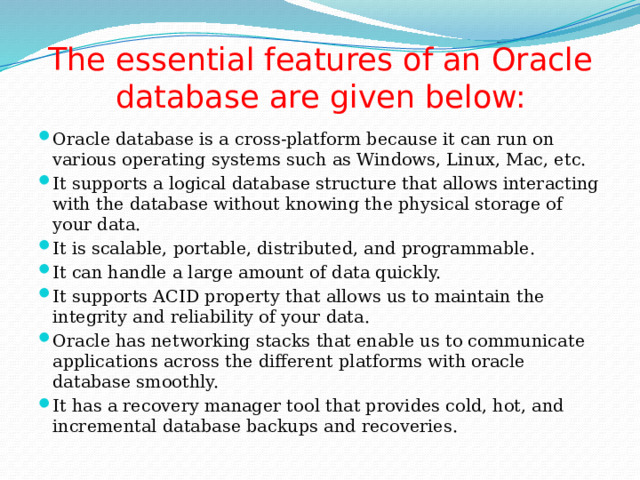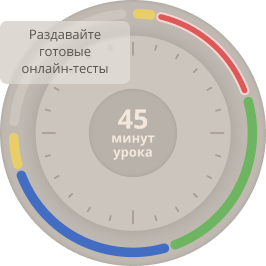
Взаимодействие с базой данных MySQL, Oracle. Переназначение адреса. Модуль mod-rewrite. Перезапись URL по шаблону

Difference between MySQL and Oracle
- MySQL and Oracle are the two famous relational databases that are used in small and big companies. Although Oracle Corporation supports both databases, they also have a lot of differences. Oracle is the more powerful software in comparison to MySQL.

What is MySQL?
- MySQL is the popular database management system used for managing the relational database. It is open-source database software, which is supported by Oracle Company. It is fast, scalable, and easy to use database management system in comparison with Microsoft SQL Server and Oracle Database. It is commonly used with PHP scripts for creating powerful and dynamic server-side or web-based enterprise applications.
- It is developed and supported by the Swedish Company, MySQL AB , and written in C and C++ programming languages . Many small and big companies use MySQL. MySQL supports many Operating Systems like Windows, Linux , MacOS, etc. with C , C++, and Java languages .

The essential features of the MySQL database are given below:
- MySQL is a relational database management system and easy to use. We can build and interact with MySQL by using only a few simple SQL statements.
- It is secure because passwords are encrypted in MySQL.
- It follows a client /server architecture.
- It is free and open-source.
- It is scalable.
- It allows transactions to be rolled back, commit, and crash recovery.
- It provides high performance, high flexibility, and high productivity.

What is Oracle?
- Oracle is a relational database system that provides self-driving, self-securing, self-repairing, and designed to eliminate error-prone manual database management. Oracle is a cross-platform database system which can run on the various operating system. It allows to store and retrieve data quickly and safely. It is available free for the student but cannot use for commercial purposes. It is the first database software developed for business purposes to manipulate data using a query language. Oracle was released in 1980 with basic SQL features. This software is scalable, portable, distributed, and programmable.

The essential features of an Oracle database are given below:
- Oracle database is a cross-platform because it can run on various operating systems such as Windows, Linux, Mac, etc.
- It supports a logical database structure that allows interacting with the database without knowing the physical storage of your data.
- It is scalable, portable, distributed, and programmable.
- It can handle a large amount of data quickly.
- It supports ACID property that allows us to maintain the integrity and reliability of your data.
- Oracle has networking stacks that enable us to communicate applications across the different platforms with oracle database smoothly.
- It has a recovery manager tool that provides cold, hot, and incremental database backups and recoveries.

Вставьте пропущенные слова в предложения: cross-platform, packages, communicate, Swedish, free, flexibility, static, database
1. MySQL is the popular _________ management system used for managing the relational database.
2. MySQL is developed and supported by the _________ Company.
3. MySQL provides high performance, high ________ , and high productivity.
4. Oracle is a _________ database system which can run on the various operating system.
5. Oracle is available ________ for the student but cannot use for commercial purposes.
6. Oracle has networking stacks that enable us to __________ applications across the different platforms with oracle database smoothly.
7. Oracle supports many storage features that are tablespace, synonym, _________ , etc.
8. MySQL only works with the _______ system.

Ответьте на вопросы:
1. By which company is MySQL supported?
2. Are passwords encrypted in MySQL?
3. What does MySQL allow transactions to do?
4. Is Oracle available free for the student and commercial purposes?
5. When was Oracle released?
6. Which type of software does Oracle have?
7. What storage features do MySQL and Oracle have?

































